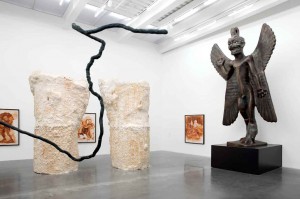« Reviews
Skin Fruit: Selections from the Dakis Joannou Collection

Installation view of "Skin Fruit: Selections from the Dakis Joannou Collection," curated by Jeff Koons. Photo Benoit Pailley. Courtesy New Museum, New York.
New Museum - New York
Curated by Jeff Koons
“Skin Fruit”: A controversial show at the New Museum
By Ernesto Menéndez-Conde
Once more, Jeff Koons has created a scandal– but this time, not as an artist. His curatorial work for “Skin Fruit: Selections from the Dakis Joannou Collection,” shown at the New Museum, has elicited many bad reviews. This is actually great. More often than not, contemporary art lacks the passion which someone might expect from the provocations it tries to posit, and everyone knows how fruitful polemics are for marketing a product. In today’s artistic scenario, a scandal is a sign of success. It is ironic that an institution like the New Museum, which has developed its identity through the promotion of rather non-mainstream artists, has become controversial by exhibiting a constellation of stars: Cindy Sherman, Jenny Holzer, Mathew Barney, Kara Walker, Mike Kelley, Charles Ray, Richard Prince, Mauricio Cattelan, Chris Offili, Robert Gober, Cady Noland, Vanessa Beecroft, Kiki Smith, Christopher Wool, Urs Fisher, and Jeff Koons himself, among many others. As Roberta Smith of the New York Times has observed: “Nearly all emanate from one stratum of the art world: the one where the money is.” There is also an arguable alliance between the non-profit museum and the private collector. It seems as if Dakis Joannou was merely subletting three floors and the lobby of the building, under the title “The Imaginary Museum,” as the institution has announced a series of shows devoted to private collections. Finally there is the Koons’ curatorial project, which seems amateur and chaotic (if not disastrous). From the institutional level to the actual display of the artworks, “Skin Fruit” must be seen as a provocative spectacle.
What I find disturbing about “Skin Fruit” is the arrangement of the pieces. There is a disharmonic conjunction of installations, drawings, videos, sculptures, and performances. On the fourth floor, for instance, the large-scale replica of the Assyrian demon Pazuzu by Roberto Cuoghi (2008) seems to rule the hall, alluding to the chaos of the whole. Terence Koh’s installation, which resembles two natural pillars made of white chocolate, is against the background of a series of five of Kara Walker’s drawings with representations of sexual images related to slavery. There is an Urs Fisher installation: a sinuous line, like an abstraction floating in the space just behind a sort of column, with a pyramid form made of mirrors. In the right corner there is a blonde female mannequin wearing a blue suit, a work by Charles Ray. This mixture couldn’t look worse, as if the pieces were placed at random by someone who has not the slightest idea about curating an art show. Does the ugly displacement of the pieces obey an aesthetic choice, rather than a lack of expertise from the curator’s side? That is probably dubious, but there are at least two dimensions which could be related to the intentional ugliness.
The first one has to do with the main ideas of the show. In the notes launched by the New Museum there is an explanation about what “Skin Fruit” means: “‘Skin Fruit’ alludes to notions of genesis, evolution, original sin, and sexuality. ‘Skin’ and ‘fruit’ evoke the tensions between interior and exterior, between what we see and what we consume.”
As Peter Schjeldahl has noticed, the title has also a playful meaning, namely the phonetic proximity between “skin fruit” and “skin flute,” which is slang for the penis.1 This association suggests a sense of the grotesque, which fits many of the works shown. There is the grotesque in artworks such as Intestine, a long segment that obviously represents excrements, made by Kiki Smith, who also shows two wax figures depicted in self-satisfactory, masturbatory practices (Mother/Child), or in Paul McCarthy’s sculpture of pigs with human faces, copulating in an orgy. (Among many other works.) There is also primitive sexuality, sadism, the macabre, and cadavers. Therefore, fear and ugliness could be easily linked to Koons’ curatorial choices.
The second reason for creating an ugly arrangement is precisely to provoke and shake the art world. At the end, a female guardian sings in the performance by Tino Sehgal, “This is propaganda, you know, you know…”
NOTES
1 See, Schjeldahl, Peter. “Big Time. ‘Skin Fruit’ at the New Museum”. 15 March 2010. <http://www.newyorker.com/arts/critics/artworld/2010/03/15/100315craw_artworld_schjeldahl.>
Filed Under: Reviews


































